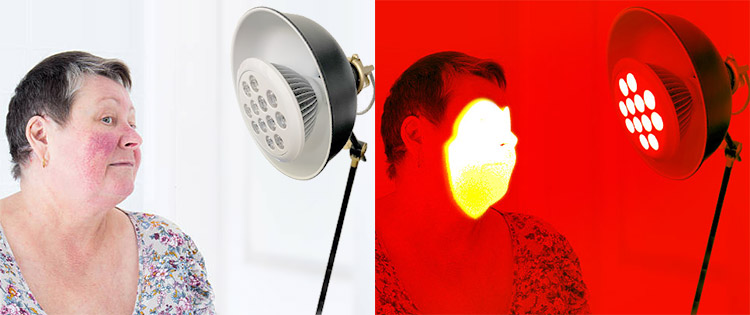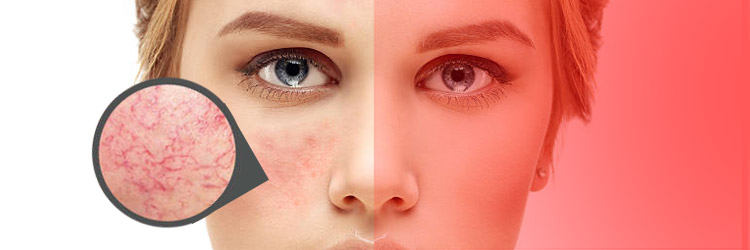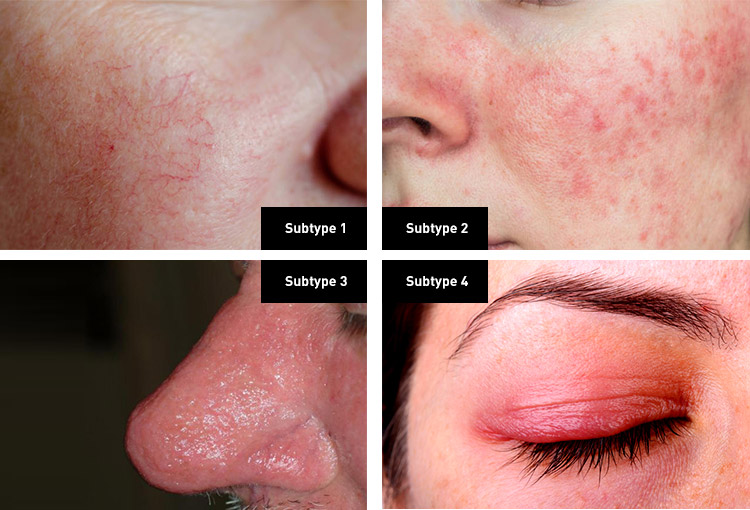Rosacea is a condition typically characterised by facial redness and swelling. It affects about 5% of the global population, and although the causes are known, they are not very widely known. It is considered a long-term skin condition, and most commonly affects European/Caucasian women above the age of 30. There are various subtypes of rosacea and it can affect anyone.
Red light therapy is well studied for things like skin healing, inflammation in general, collagen in the skin, and various related skin conditions such as acne. Naturally the interest has grown in using red light for rosacea. In this article we will look at whether or not red light therapy (also known as photobiomodulation, LED therapy, laser therapy, cold laser, light therapy, LLLT, etc.) can help to treat rosacea.
Table of contents
Types of Rosacea
Everyone who has rosacea has slightly different and unique symptoms. While rosacea is commonly associated with facial redness around the nose and cheeks, there are various other symptoms which can be broken down and categorised into rosacea ‘subtypes’:
- Subtype 1, referred to as ‘Erythematotelangiectatic Rosacea’ (ETR), is the stereotypical rosacea that presents with facial redness, skin inflammation, blood vessels near the surface and periods of flushing. Erythema comes from the Greek word erythros, which means red – and refers to red skin.
- Subtype 2, Acne rosacea (scientific name – papulopustular), is rosacea where red skin is combined with persistent or intermittent acne-like breakouts (pustules and papules, not blackheads). This type can cause a burning or stinging sensation.
- Subtype 3, A.K.A phymatous rosacea or rhinophyma, is a rarer form of rosacea and involves parts of the face getting thicker and larger – typically the nose (potato nose). It is most common in older men and typically starts off as another subtype of rosacea.
- Subtype 4 is rosacea of the eye, or ocular rosacea, and it involves bloodshot eyes, watery eyes, a feeling of something in the eye, burning, itching and crusting.
Knowing about the subtypes of rosacea is important in determining if you actually have it. If nothing is done to address rosacea, it tends to get worse over time. Fortunately, the applicability of red light therapy to treating rosacea doesn’t change with the subtype. Meaning the same red light therapy protocol would work for all subtypes. Why? Let’s look at the causes of rosacea.
The Real Cause of Rosacea
(…and why light therapy can help)
Several decades ago, rosacea was initially believed to be the result of a bacterial infection. As antibiotics (including tetracycline) worked to a degree to manage symptoms, it seemed like a good theory….but quite quickly it was discovered that there are no bacteria involved.
Most doctors and experts on rosacea these days will tell you that rosacea is enigmatic and nobody has discovered the cause. Some will point to Demodex mites as the cause, but almost everyone has these and not everyone has rosacea.
Then they will instead list various ‘triggers’ in place of the cause, or make suggestions that unspecified genetics and environmental factors are the cause. Although genetic or epigenetic factors can predispose someone to getting rosacea (relative to another person), they don’t determine it – they are not the cause.
Various factors do definitely contribute to the severity of rosacea symptoms (caffeine, spices, certain foods, cold/hot weather, stress, alcohol, etc.), but they too are not the root cause.
So what is?
Clues to the cause
The first clue to the cause is in the fact that rosacea usually develops after age 30. This is the age when the first signs of aging become apparent. Most people will notice their first grey hair and first minor skin wrinkle around this age.
Another clue is the fact that antibiotics help to manage symptoms – even though there is no actual infection (hint: antibiotics can have short term anti-inflammatory effects).
Blood flow to skin affected by rosacea is 3 to 4 times higher than to normal skin. This hyperemia effect occurs when tissues and cells are unable to extract oxygen from the blood.
We know that rosacea is not merely a cosmetic issue, but involves significant fibrotic growth changes to the skin (hence the potato nose in subtype 3) and invasive blood vessel growth (hence veins/flushing). When these exact same symptoms happen elsewhere in the body (e.g. uterine fibroids) they warrant significant investigation, but in the skin they are dismissed as cosmetic issues to be ‘managed’ by ‘avoiding triggers’, and later even surgeries to remove the thickened skin.
Rosacea is a significant issue because the root cause is physiological processes deeper in the body. The physiological state leading to these skin changes isn’t only affecting the skin – it affects the entire internal body as well.
The flushing, the growing/invasive blood vessels and the thickening of the skin can be observed readily in rosacea, because it is apparent in the skin – the surface of the body. In a way, it is a blessing to get rosacea symptoms, because it shows you that something is wrong inside. Male pattern hair loss is a similar thing in that it points to underlying hormonal dysregulation.
Mitochondrial defects
All of the observations and measurements regarding rosacea point to mitochondrial problems as the root cause of rosacea.
Mitochondria cannot use oxygen properly when they are damaged. The inability to use oxygen increases blood flow to a tissue.
Mitochondria produce lactic acid when they can’t get and use oxygen, which leads to immediate vasodilation and the growth of fibroblasts. If this problem is prolonged over a period of time, new blood vessels start to grow.
Various hormonal and environmental factors can contribute to poor mitochondrial function, but in the context of red light therapy, the most important impact is from a molecule called Nitric Oxide.
Red Light Therapy and Rosacea
The main theory explaining the light therapy effects is based on a molecule called Nitric Oxide (NO).

This is a molecule that can have various effects on the body, such as inhibiting energy production, vasodilation/expanding of blood vessels, and so on. The one we are mainly interested in for light therapy is that this NO binds at a key location in your mitochondrial electron transport chain, stopping energy flow.
It blocks the final stages of the respiration reaction, so stops you getting the main chunk of energy (ATP) and any carbon dioxide from glucose/oxygen. So when people have permanently lower metabolic rates as they age or undergo periods of stress/starvation, this NO is usually responsible. It makes sense when you think about it, in nature or in survival, you need a mechanism to lower your metabolic rate in times of lower food/calorie availability. It doesn’t make much sense in the modern world where NO levels can be influenced by specific types of amino acids in the diet, air pollution, mold, other diet factors, artificial light, etc. The lack of carbon dioxide in our body also ramps up inflammation.

Light therapy increases production of both energy (ATP) and carbon dioxide (CO2). The CO2 in turn inhibits various pro-inflammatory cytokines and prostaglandins. So light therapy reduces the amount of inflammation in the body/area.
For rosacea the key takeaway is that light therapy is going to reduce inflammation and redness in the area, and also resolve the problem of low oxygen consumption (which caused the blood vessel growth and fibroblast growth).
Summary
There are various subtypes and manifestations of rosacea
Rosacea is a sign of aging, like wrinkles and grey hair
The root cause of rosacea is reduced mitochondrial function in cells
Red light therapy restores mitochondria and reduces inflammation, preventing rosacea
References
- Photodynamic therapy in the treatment of rosacea. Nybaek et al. 2005
- Rosacea, inflammation, and aging: The inefficiency of stress. Ray Peat. 2013
- Light-emitting diodes downregulate cathelicidin, kallikrein and toll-like receptor 2 expressions in keratinocytes and rosacea-like mouse skin. Lee et al. 2016
- Photodynamic and photobiological effects of light-emitting diode (LED) therapy in dermatological disease: an update. Sorbellini et al. 2018
- Effects of 5-aminolevulinic acid-mediated photodynamic therapy on antibiotic-resistant staphylococcal biofilm: an in vitro study. Li et al. 2013
- Is light-emitting diode phototherapy (LED-LLLT) really effective? Kim et al. 2011
- Patient perspectives on low level light therapy and laser therapies for rosacea-associated persistent facial redness. McGinley et al. 2014
- Rosacea: II. therapy. Pelle et al. 2004



Hi just received my red mini 670 im a bit confused about
What distance from my face for first time use
How long to use for 5min ,10 min
Any advice would be greatly appreciated
Many thanks
Ber
30cm / 12 in for about 5 minutes.
Hi there, I was wondering if you could help me, I’ve recently purchased a Red-Infrared Combo Light, for inflammation In the body gut, Rosacea and bad hair loss.Would I do sessions separately? Or at the same time? How far from the body would I need to be for these sessions to get optimum results for both? Thank you.
Either, you can do it all in the same session (3 sessions back to back), or at different times – it doesn’t matter much.
For rosacea and the scalp, a 10 inch distance for 3-5 minutes works.
For the gut, a distance of closer than 5 inches is better because you need more intense light for deeper penetration.
Hi, I’ve read that some right light devices can actually cause skin irritation and/or damage the skin (not sure if permanently). Is this really possible? Could it be those devices were not medically certified? Thanks
There was probably some blue or UV light in those.
Hi. I’m currently having success with amber/ yellow light therapy at my local salon for my rosacea. It’s getting expensive though. Would one of your red lights work in the same way, thanks!
Could you please inform me which one of your lights you would recommend for subtype 1 rosacea.
Regards
Guten Tag! Welche Ihrer Lampen aus dem Sortiment sind am besten gegen Rosacea geeignet?
Hi – Wondering if you could advise; would infrared offer the same benefits for Rosacea, or does it have to be red frequency only? Thanks in advance.
I have acne rosacea would the red light help
Could the infrared mini be used on a csection scar as well? If so, recommendations on dosing?
Could you please inform me which one of your lights you would recommend for subtype 2 rosacea.
Regards
How often should you use it for skin conditions? Should it be every day or….?
It depends, but in general 4x per week.
Hi! I’m thinking of purchasing a red/infrared combo mainly for managing rosacea but I have heard that NIR sometimes can cause local fatloss.
Is this really the case? Thanks in advance 😊
We’ve never had a customer mention this, nor have I ever seen it in studies.
The key idea to understand is that energy and structure are interdependent. If your body makes more energy, that reinforces the healthy structure. Since light therapy restores normal energy generation, it works against the causes of aging, and negative structural changes like a gaunt or droopy face.
Even if you did use light therapy with a higher dose in order to affect fat cells below the skin, you’re just restoring their normal function – it is not a rampant energy burning effect. You’re just putting the cells back into their healthy state, rather than an energy deficient stressed state.
So if you have excess fat from being in a sluggish metabolism, light therapy when combined with a change in diet might aid spot fat loss, but it is only correcting the unhealthy state.
Can you help me determine distance and time to use my red light panel for Rosacea and/or aging (fine lines/wrinkles)……my specs are below. Not an expensive model – just want to make sure I am using long enough and close enough. Thank you.
Irradiance is 90mW/cm2.
Coverage is 54m2 at 20 inches.
Wavelengths = 660NM Red Light &850NM Near-Infrared Light – Yes.
“Dose (in J/cm2) = Power Density (in mW/cm2) x Time (in seconds) x 0.001.
That’s 90*60*0.001=5.4J.”
75 LED – Dual Chip
Panel size 13inch*4.7inch – includes tripod
The specs don’t make sense. Irradiance changes by distance, so what distance is that irradiance from?
54m2 is a massive area. That’s like the entire wall of a 2 story house.
Anyway, yes, if the distance that gives 90mw/cm2 irradiance is maintained for a minute. The dose is 5.4 J/cm2.
That’s what the outer layer of skin cells will get in a minute. With deeper layers getting less. You can consider 3 minutes or so to get more comprehensive effects in the full skin.
Hey Joe 🙂 just ordered the Red Light Device Mini to use for some light acne and anti aging. I’ve been looking at your dosing page but math is not my forte lol. Would 25cm away for 5 mins work for this device? Thanks so much
Hi Mal, yes, that is our recommendation for skin health, including acne. At least 4 sessions a week.
Thanks Joe, just got the product and WOW so impressed with the quality and size! I thought it would be small. Excited to try!